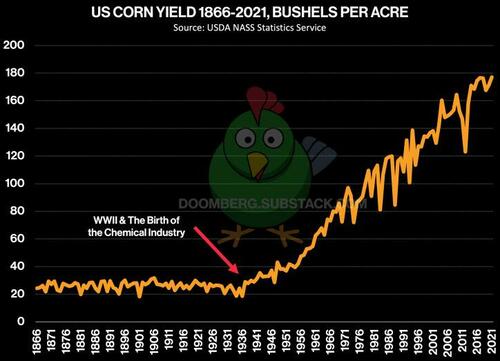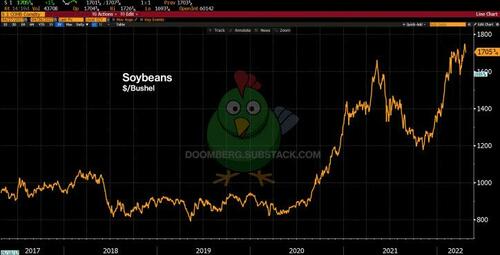Diesel For Dinner
“Governing a great nation is like cooking a small fish – too much handling will spoil it.” – Lao Tzu
The words edible and eatable are often used interchangeably but embedded within their respective definitions is a distinction that makes an important difference. Edible means “safe to eat,” whereas eatable means “pleasant to eat.” A variant of the word eatable is delicious, commonly defined as “highly pleasant to eat.” Delicious certainly sounds more enticing than highly eatable, a phrase nobody would use to compliment an exquisite meal crafted by a professional chef. We find such linguistic nuances pleasing.
Whether the balance of calories a person consumes is edible, eatable, or delicious depends on where they sit on Maslow’s hierarchy of needs, a concept we covered at length in a piece we wrote last July called Why Are Cows Sacred? For those at the base of the pyramid, the struggle to consume enough edible food just to see another sunrise defines much of their existence. At the top of the pyramid sit those fortunate souls who can afford to cook delicious meals with fresh ingredients, eat at fine restaurants, or even hire a personal chef to tend to their every dietary indulgence.
At the molecular level, the distinction between edible and inedible can be subtle. The rearrangement of a few atoms within an otherwise similar chemical structure can make the difference between satiation and a trip to the emergency room. Prior to the advent of the modern chemical and energy industries, humanity leveraged animal and plant byproducts to create many of the functional materials used in daily life, making the tradeoff between food and other needs a more visceral one than it is today. The edible parts were eaten, and the inedible stuff – presumably identified through an unfortunate series of trial and error experiments – was converted into other useful things or burned to create energy.
Armed with humanity’s mastery of chemistry, we can now rearrange atoms with astonishing specificity at an unimaginable scale, pushing billions of people further up Maslow’s hierarchy than they would otherwise be. In addition to using fossil fuels to create most of the materials that surround us, we leverage them to produce fertilizers, herbicides, fungicides, and other inputs into the farming process, boosting crop yields to levels once thought impossible. We also synthesize mountains of edible ingredients directly from oil and gas. Touring a modern food processing factory would seem almost indistinguishable from a specialty chemical plant, mostly because they aren’t all that different.
While it makes perfect sense to leverage our bounty of fossil fuels and ability to manipulate them at the molecular level to increase global food abundance, going through the effort to grow food only to turn around and burn it for energy seems less than ideal. In a controversial piece we wrote in January titled “In Praise of Corn Ethanol,” we put forth a theory that the adoption of corn ethanol as a mandated additive to gasoline was a scheme to coverup one of the greatest environmental scandals of the past century: the use of tetraethyl lead as an anti-knock agent. While some readers interpreted our piece as supporting this policy – undoubtedly because of the title – our primary purpose was to highlight the ugly history that got us to the current situation, and how it was predominantly a dirty political compromise. In hindsight, “Why Corn Ethanol is a Thing” might have been a better title.
No such compromise underpins the decision to use foodstuffs as replacements for diesel, a policy that will make the unfolding global food crisis substantially worse if it is not soon overturned.
When a barrel of oil is refined, it is separated into various products using the different boiling points of its components. Gasoline boils at a lower temperature than diesel and represents about 43% of each barrel of oil. Diesel makes up approximately 27%, with the other 30% destined to become heating oil, jet fuel, asphalt, and other important materials. Because of its higher energy density per gallon and the efficiency of engines designed to use it, diesel is a desirable fuel, especially for long-haul trucking.
Trucks at the pump | Getty Images
Unfortunately for those near the bottom of Maslow’s pyramid, many cooking oils – liquid fat isolated from various crops used extensively in frying, baking, and other types of food preparation all over the world – have a molecular structure quite similar to that of diesel. It does not take much chemical magic to transform previously edible cooking oils into workable substitutes for the valuable fuel. Now that the environmental lobby has convinced government officials worldwide that “renewable carbon content” is prima facia a desirable thing – a fallacy that deserves its own Doomberg piece – various mandates exist to literally take food out of the mouths of the hungry and pump it into our trucks for burning. For the planet, and whatnot.
The first commercially relevant incarnation of a diesel substitute derived from crops is a product known as biodiesel. Oils derived from palm, sunflower, soybean, rapeseed, and castor are used as inputs, to name a few, and they are reacted with methanol (derived from fossil fuels) in a chemical process known as transesterification. Transesterification generates a product with higher oxygen content than standard diesel. This presents some challenges, including poor low-temperature performance, increased microbial growth, corrosion of engine parts, and higher shipping costs (biodiesel cannot leverage existing pipelines that are used to transport regular diesel). Much like corn ethanol, biodiesel is blended with regular diesel at concentrations between 2-20% before being marketed. Despite these limitations, government mandates have motivated farmers the world over to redirect a sizable chunk of their crops from the grocery store to the gas station.
Nearly all of the challenges with biodiesel have been overcome with the recent development of renewable diesel, a material synthesized by hydrotreating cooking oils. Here’s how the US Energy Information Agency (EIA) describes the differences (emphasis added throughout):
“Renewable diesel is a biomass-based diesel fuel similar to biodiesel, but with important differences. Unlike biodiesel, renewable diesel is a hydrocarbon that is chemically equivalent to petroleum diesel and can be used as a drop-in biofuel that does not require blending with petroleum diesel for use…
Because renewable diesel is a drop-in fuel, it meets ASTM D975 specification for petroleum diesel and can be seamlessly blended, transported, and even co-processed with petroleum diesel.”
Image credit: iStockPhoto / Lori Hays
To the truckers forced to meet renewable carbon content mandates, renewable diesel is a godsend. It requires no change on their part, is indistinguishable from regular diesel, and allows them to proudly proclaim their green bonafides. To the companies who produce it, renewable diesel is a government-mandated financial pot of gold. The US Environmental Protection Agency (EPA) issues valuable renewable identification numbers (RINs) to track compliance with various mandates and to stoke production. There’s also a national $1-per-gallon tax credit to further incentivize producers.
While support at the federal level has been important, the real driver for renewable diesel adoption has been the State of California. Through its low-carbon fuel standards (LCFS) program, credits currently trading for $115 per carbon ton are being issued, and renewable diesel is now the largest source of incremental credits. This is before the real capacity to produce renewable diesel comes online.
Where will all this renewable diesel come from? In the US, soybean oils are the main input, and it should come as no surprise that planting strategies are being quickly modified to produce more of it. This quote from an industry consultant frames the magnitude of the upcoming disruption well:
“The dramatic development of the U.S. renewable diesel industry is similar to how ethanol changed the U.S. corn industry from 2007 to 2010, says Dan Basse, president of AgResource Company. But he believes renewable diesel could be more disruptive.
‘We are calling for 90.5 million soybean acres in 2022 versus this year’s 87 million, and that just gets us started in meeting renewable diesel demand,” he says. “Then we’d need to increase soybean acres by 5 million to 7 million each year. We have to top 120 million acres of soybeans to meet the growing demand for renewable diesel.’”
With the force of the government’s thumb on the scale of demand compounding pre-existing inflationary pressures hitting farmers, the price of soybeans has soared to fresh all-time highs. At the time of this writing, soybeans trade for $17 per bushel, more than double the price seen just two years ago. Unless these policies are unwound, it is difficult to imagine a scenario where positive price momentum abates.
In a piece we wrote last October called Starvation Diet, we warned that the unfolding energy crisis would trigger a global famine, a process that would be exacerbated by protectionism. Here’s a key passage:
“We’ve written extensively about how the market for energy in Europe broke and how the ripple effects will snap through our delicate supply chains like a whip. When the supply of critical goods goes short, countries implement protectionist policies in a futile attempt to minimize the impact at home. A cascading series of retaliatory moves usually follows, leading to economic vapor lock. We are seeing that pattern play out now in agriculture.”
Although we take no joy in being proven right in this regard, more evidence of our prescience emerged last week when Indonesia shocked the world by banning all exports of palm oil. Cooking oils can be substituted for each other and price pressures on one oil inevitably puts a bid under the others. Here’s how The Guardian describes the situation:
“The price of edible oils such as soyoil, sunflower oil and rapeseed oil is expected to rise after Indonesia announced a surprise export palm oil ban, experts have warned.
Major edible oils are already in short supply due to adverse weather and Russia’s invasion of Ukraine. The move by Indonesia to pause exports will place extra strain on cost-sensitive consumers in Asia and Africa hit by higher fuel and food prices.”
The magnitude of this ban cannot be overstated. According to data from Statista, palm oil accounted for 35% of all cooking oil produced last year. Indonesia is responsible for a staggering 60% of global palm oil production. The blast waves emanating from this explosive move will be felt the world over, most acutely by those already on the brink that can least afford to react. Bluntly, people are going to starve.
In the face of a global energy crisis, the war in Ukraine, food shortages, and rampant inflation, does it make sense to be redirecting so many acres of valuable cropland to make renewable diesel, a fuel we can easily and directly drill for domestically? Do our policymakers understand the interconnected nature of these markets, and how forcing a strong link between diesel and soybeans creates a tunnel through which the contagion of crisis in one market bleeds directly into the other? Imagine how grotesque this spectacle must seem to the most vulnerable among us. While they scramble to secure enough edible food to survive, our elite know-it-alls gorge themselves on the most delicious hors d’oeuvres the cocktail party circuit can provide. Through either shocking ignorance or callous indifference, they convince themselves they are saving the planet.
Saving the planet for who, exactly? The poorest citizens on Earth? Nah.
Let them eat diesel.
* * *
Tyler Durden
Sun, 05/01/2022 – 14:00
via ZeroHedge News https://ift.tt/rWbqZVE Tyler Durden





